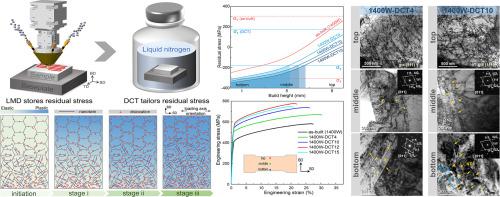当前位置:
X-MOL 学术
›
Int. J. Plasticity
›
论文详情
Our official English website, www.x-mol.net, welcomes your
feedback! (Note: you will need to create a separate account there.)
Optimization of tensile properties and anisotropy in a cryogenically treated laser additively manufactured high entropy alloy
International Journal of Plasticity ( IF 9.4 ) Pub Date : 2024-06-01 , DOI: 10.1016/j.ijplas.2024.104015 Yuan Tian , Yunzhuo Lu , R. Lakshmi Narayan
International Journal of Plasticity ( IF 9.4 ) Pub Date : 2024-06-01 , DOI: 10.1016/j.ijplas.2024.104015 Yuan Tian , Yunzhuo Lu , R. Lakshmi Narayan

|
Repetitive deep cryogenic soaking treatment (DCT) of laser metal deposition (LMD) processed CrMnFeCoNi high entropy alloy (HEA) significantly enhances its strength without compromising ductility. This is attributed to the compressive stress induced nanotwin formation, which in turn facilitates twin induced plasticity. In this work, a parametric study on the effect of the residual stress profile and the DCT cycles on the tensile properties of the HEA, along the build and scan directions is conducted. Towards this end, builds fabricated with 5 different laser powers, 1100, 1400, 1700, 2000 and 2300 W, are examined and the ones with highest and lowest residual stress gradient are considered for further DCT treatments. Results indicate that the build fabricated with 1400 W laser power, which has the highest gradient in initial residual stresses, exhibits a greater enhancement in dislocation and twin density with increasing number of DCT treatments. Compared to its as-built state the peak yield and tensile strength of the HEA (along the scanning direction) increases to 592 ± 13 and 778 ± 15 MPa, without significant decrease in its ductility after 12 DCT cycles. However, the enhancement in the dislocation, twin density and therefore, the strength, is minimal after it is treated to 15 DCT cycles. Anisotropy in both strength and ductility, which is of the order of 20-25 %, is also observed in the DCT treated builds along the build and scan directions. These observations were rationalized on the basis of dislocation and twin evolution and distribution during DCT and deformation of the build when deformed in different directions. Implications of these results in the context of employing DCT for strengthening LMD fabricated HEA components are discussed.
中文翻译:

低温处理激光增材制造高熵合金拉伸性能和各向异性的优化
对激光金属沉积 (LMD) 加工的 CrMnFeCoNi 高熵合金 (HEA) 进行重复深冷浸泡处理 (DCT),可在不影响延展性的情况下显着提高其强度。这归因于压应力诱导的纳米孪晶的形成,这反过来又促进了孪晶诱导的塑性。在这项工作中,我们对残余应力分布和 DCT 循环对 HEA 沿着构建和扫描方向的拉伸性能的影响进行了参数化研究。为此,我们对使用 5 种不同激光功率(1100、1400、1700、2000 和 2300 W)制造的结构进行了检查,并考虑将具有最高和最低残余应力梯度的结构进行进一步的 DCT 处理。结果表明,使用 1400 W 激光功率制造的结构具有最高的初始残余应力梯度,随着 DCT 处理次数的增加,位错和孪晶密度呈现出更大的增强。与建成状态相比,HEA 的峰值屈服强度和拉伸强度(沿扫描方向)增加至 592 ± 13 和 778 ± 15 MPa,12 个 DCT 循环后其延展性没有显着下降。然而,在经过 15 个 DCT 循环处理后,位错、孪晶密度以及强度的增强是最小的。在 DCT 处理的构建中,沿构建和扫描方向也观察到强度和延展性的各向异性(约为 20-25%)。这些观察结果基于 DCT 过程中的位错和孪晶演化和分布以及在不同方向变形时的结构变形而合理化。讨论了这些结果在采用 DCT 来强化 LMD 制造的 HEA 组件的背景下的含义。
更新日期:2024-06-01
中文翻译:

低温处理激光增材制造高熵合金拉伸性能和各向异性的优化
对激光金属沉积 (LMD) 加工的 CrMnFeCoNi 高熵合金 (HEA) 进行重复深冷浸泡处理 (DCT),可在不影响延展性的情况下显着提高其强度。这归因于压应力诱导的纳米孪晶的形成,这反过来又促进了孪晶诱导的塑性。在这项工作中,我们对残余应力分布和 DCT 循环对 HEA 沿着构建和扫描方向的拉伸性能的影响进行了参数化研究。为此,我们对使用 5 种不同激光功率(1100、1400、1700、2000 和 2300 W)制造的结构进行了检查,并考虑将具有最高和最低残余应力梯度的结构进行进一步的 DCT 处理。结果表明,使用 1400 W 激光功率制造的结构具有最高的初始残余应力梯度,随着 DCT 处理次数的增加,位错和孪晶密度呈现出更大的增强。与建成状态相比,HEA 的峰值屈服强度和拉伸强度(沿扫描方向)增加至 592 ± 13 和 778 ± 15 MPa,12 个 DCT 循环后其延展性没有显着下降。然而,在经过 15 个 DCT 循环处理后,位错、孪晶密度以及强度的增强是最小的。在 DCT 处理的构建中,沿构建和扫描方向也观察到强度和延展性的各向异性(约为 20-25%)。这些观察结果基于 DCT 过程中的位错和孪晶演化和分布以及在不同方向变形时的结构变形而合理化。讨论了这些结果在采用 DCT 来强化 LMD 制造的 HEA 组件的背景下的含义。











































 京公网安备 11010802027423号
京公网安备 11010802027423号